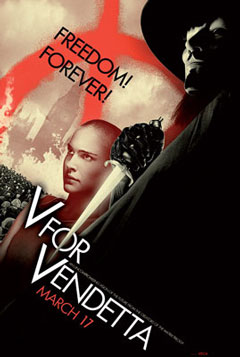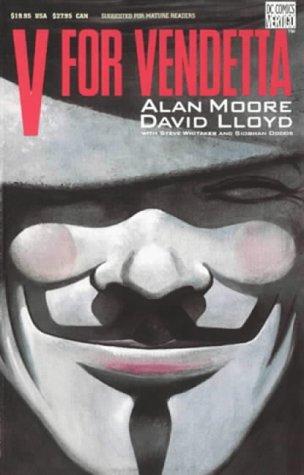(Editor’s note: With the release of the “Watchmen” film – and an upcoming Text-to-Screen Ratio of the same – I’m going to take a retrospective look back at another Alan Moore adaptation. Be aware of possible spoilers for both works as once again differences in ending will be discussed.)
 With the first three entries in this series now complete, a pattern has likely become clear to my readers: I am a purist when it comes to adapting books to film. When I go to see an adaptation, I want to see how close they come to matching my vision of the book and how well they represent the little details I remember. Consequently, a film that deviates too much from the source triggers the critical part of my brain, producing reactions usually on par with the gut reaction of Star Wars fans after their first viewing of “The Phantom Menace.”
With the first three entries in this series now complete, a pattern has likely become clear to my readers: I am a purist when it comes to adapting books to film. When I go to see an adaptation, I want to see how close they come to matching my vision of the book and how well they represent the little details I remember. Consequently, a film that deviates too much from the source triggers the critical part of my brain, producing reactions usually on par with the gut reaction of Star Wars fans after their first viewing of “The Phantom Menace.”
However, I do believe it is possible to appreciate an adaptation if it does something with the source material that isn’t perverting it, creating a story that stands on its own. “Naked Lunch” is a personal favorite, taking other William S. Burroughs’ works and biographical elements to create a truly nightmarish tale (which is perverse in its own way, but that’s fodder for another article). Another favorite is 2005’s “V for Vendetta,” developed by the Wachowski brothers and based on Alan Moore’s 1980s graphic novel, less an adaptation and more of a spiritual successor to the original.
At first glance both book and film seems to follow the same format: after nuclear war has devastated the world a fascist government has arisen in Great Britain, built on acts of genocide and total control of the populace. A mysterious character known as V, clad in a smirking Guy Fawkes mask, conducts a terrorist crusade against the regime with the assistance of Evey Hammond, a young woman whom he saves from the secret police. An investigator named Finch is assigned to the case, but finds getting into V’s mind may very well break his own.
But twenty minutes into the film, it’s clear that while the masks look the same there’s something very different underneath. The government here is depicted as an ultra-conservative regime rather than ethnically pure fascism, with the Leader a Big Brother-type of figure and Bill O’Reilly imitators controlling the airwaves. Opposition changes as well: while in the book V was depicted as an anarchist, more interested in “goring the ideology” of his opponents, the film’s V is a romantic revolutionary out to liberate the people and avenge his own treatment at the government’s hands.
The cuts to the story are so numerous you can’t help but think the Wachowskis set their V stuntman loose with his knives on the graphic novel and let him make the edits. Subplot about political intrigue in the government is removed, as is the bulk of V’s speech hijacking the airwaves to directly challenge the population and a LSD-induced epiphany from Finch. Brutal policeman Almond is removed, as is his battered wife Rose – a key player in the story’s climax – and his replacement Creedy is upgraded to the film’s main villain and resembles Dick Cheney heading the Gestapo. And that’s not even getting into the massive subtleties Moore’s works are vibrant with.
So why am I not crucifying the film more even with all these changes? Well, part of it could be because it has to be compared to “The League of Extraordinary Gentlemen,” the other most noteworthy adaptation of an Alan Moore book, and it’s difficult to find a book more butchered by the transition to film than that. Short version is it turns a dark Victorian tale into a god-awful summer blockbuster, long version can be found here by someone far angrier than I.
Another part of it could be because the main characters are so well looked after by the actors portraying them. Hugo Weaving’s V may be less dimensional than the book, but the voice and theatrical attitude are perfect – particularly an alliterative opening monologue unique to the film. Natalie Portman has more steel in her than the book’s Evey, but she carries the same concerned tone and does very well in the gripping scenes where V tortures her into a breakdown and rebirth in the rain (the most noteworthy survivor of the transition).
But the core reason why “V for Vendetta” gets away with changing the story is that the changes are being made for a reason: to use the core characters in telling an updated message. The story is targeting the differences between liberal and conservative, removing the harsher edges of the original film and relating to the American political context of the Bush administration. V’s tagline “governments should be afraid of their people” takes on a populist tone rather than chaotic, in some senses going towards the role V set Evey up to take at the book’s end. “Vendetta” the film is at least trying to do something new with the story, updating its message in a way that resonates with the politics of its time, and I can respect that to a point.
And to offer some treats to more rabid fans, the film does keep to the skeleton of the original: the aforementioned Evey rebirth scene, the use of Beethoven’s Fifth as background music, lines such as “Ideas are bulletproof” and the image of revolutionary Guy Fawkes to blow up symbols of failed authority. It may not be perfect, but after “LXG” it’s a step in the right direction.
Final adaptation score: 5 out of 10. So many changes are made to the storyline that it borders on unrecognizable, but the film is well done enough that casual fans can watch it and appreciate the moments when scenes/quotes are copied in.



 Posted by Les Chappell
Posted by Les Chappell